The spores you can buy from this shop are delivered undiluted. They are pure spores – a really minuscule amount of spores is needed to inoculate 5 kilograms of steamed grains.
If the spores are not diluted, it can be hard to spread them evenly over your grains. In order to make the spores easier to handle, I really recommend diluting them with toasted flour.
How to dilute the spores
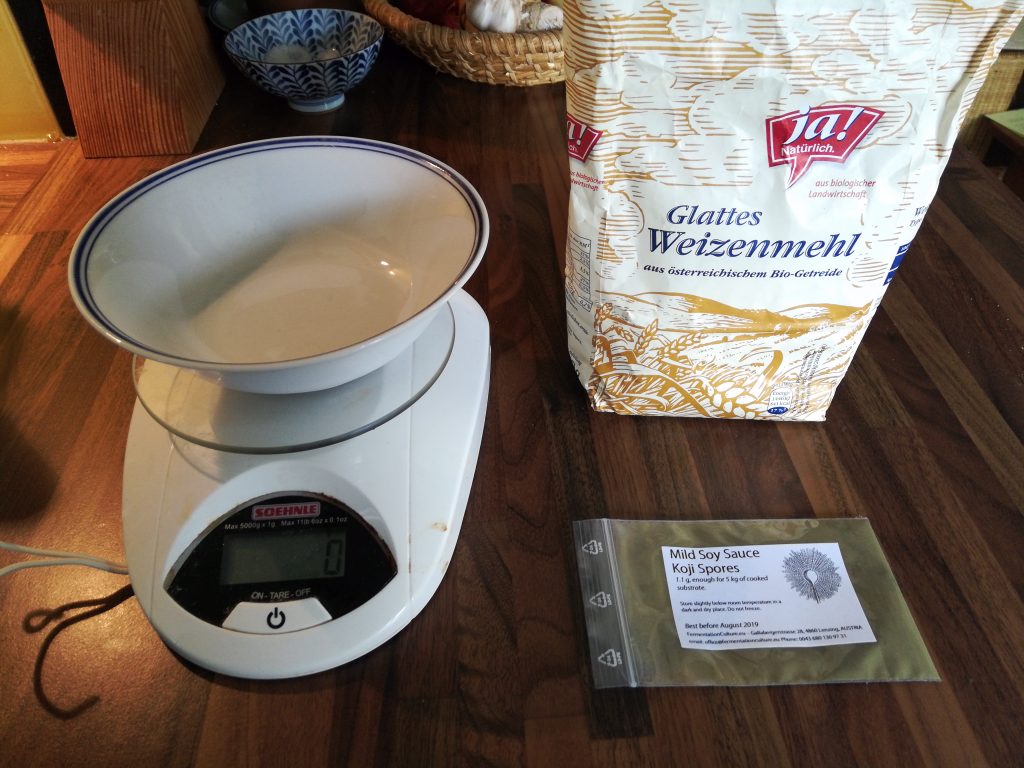
You will need a kitchen scale, a bowl, flour (can be wheat or rice flour), a pan and of course the spores.
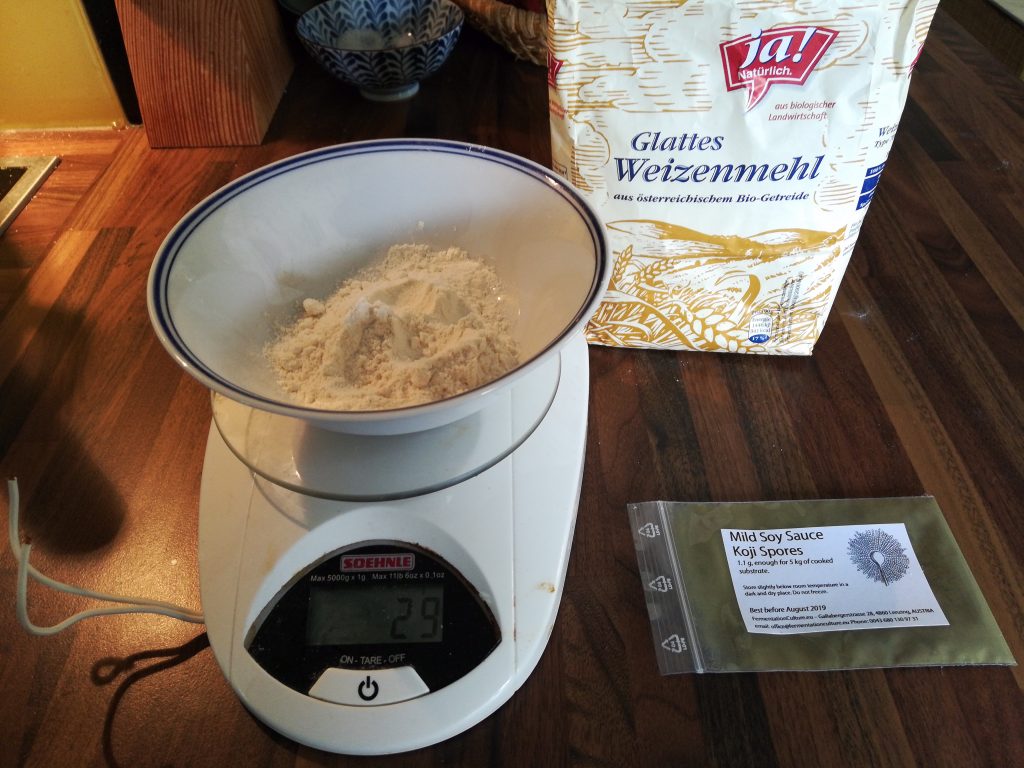
Put 29 g of flour into the bowl. It can be 30 g, as you are probably going to lose some flour in the process.
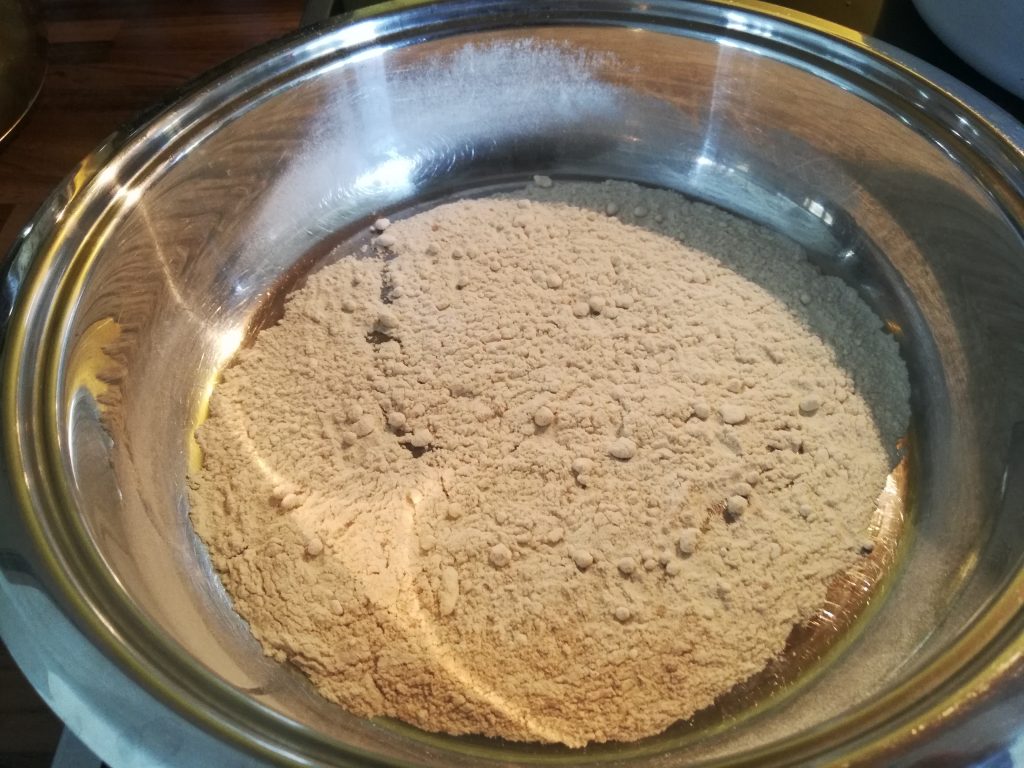
Put the flour into the pan and toast it until it gets light brown. The toasting is important to kill off any other mold spores that may be present in the flour. Be aware that the browning can happen very quickly! I have burnt the flour more often than once. Move the flour around a lot, to avoid burning it.
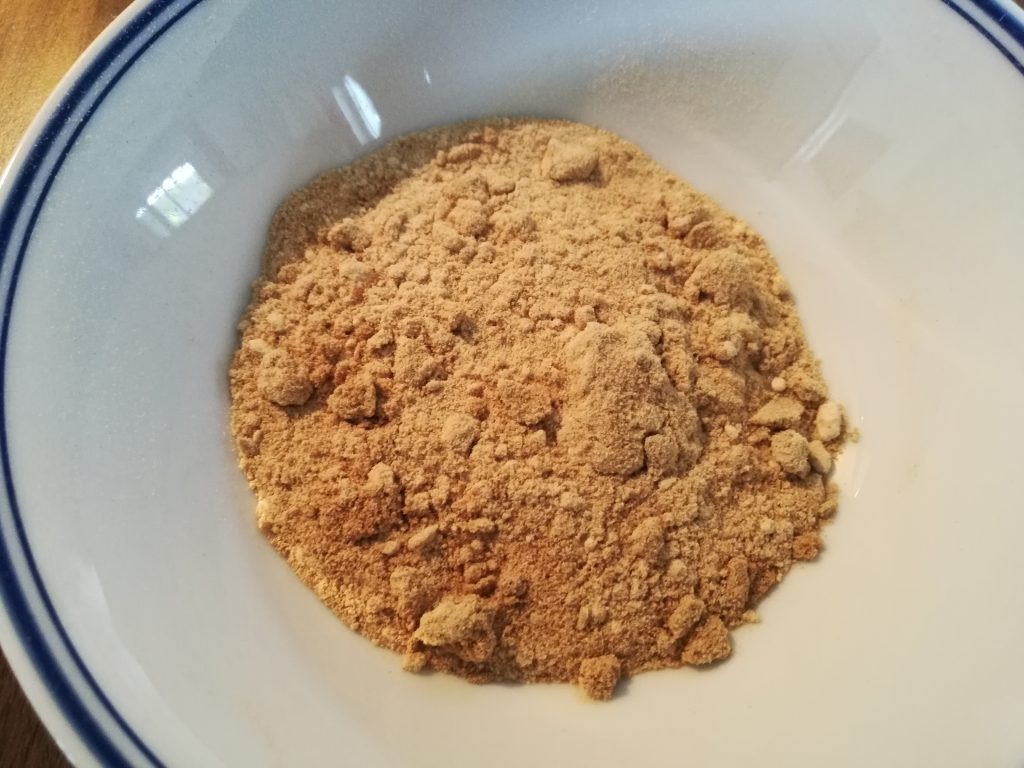
This flour is brown enough, in fact it is browner than I wanted it to be, but it is still OK.
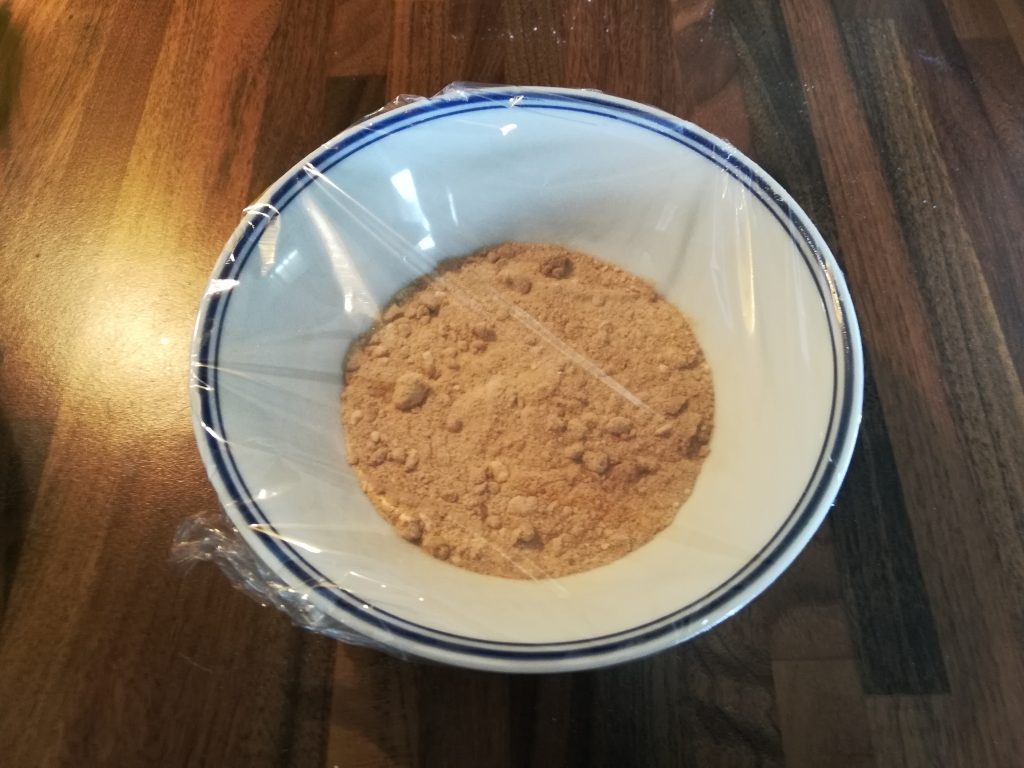
Let it cool down for some time.
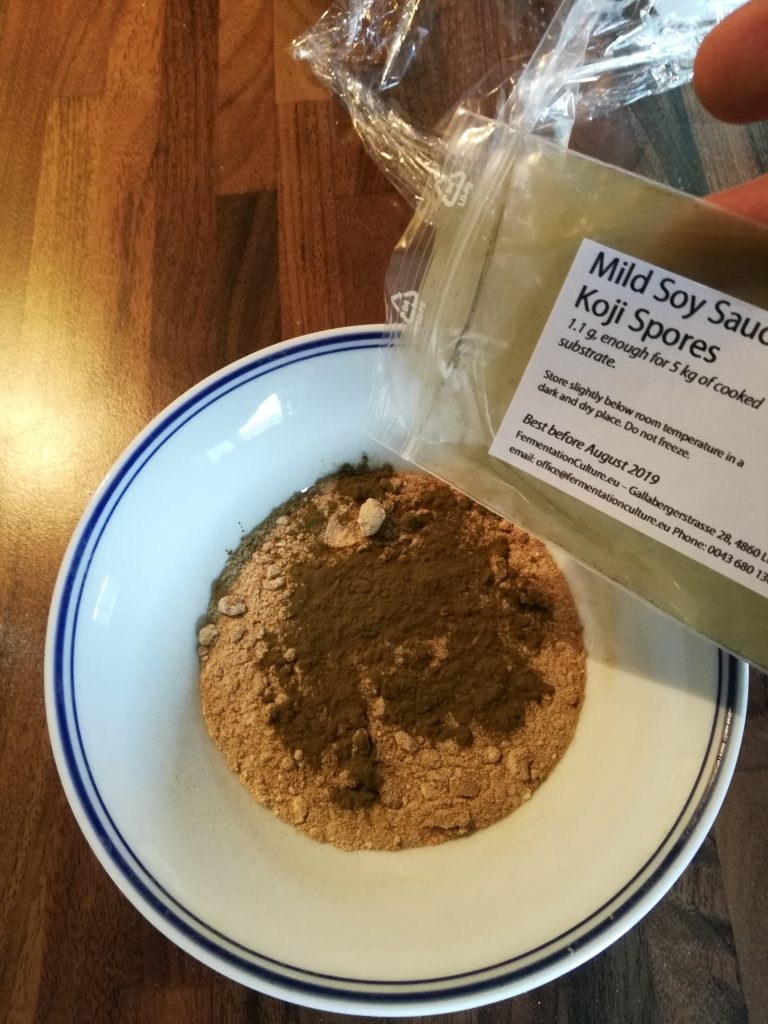
Once the flour is cool, add the spores.
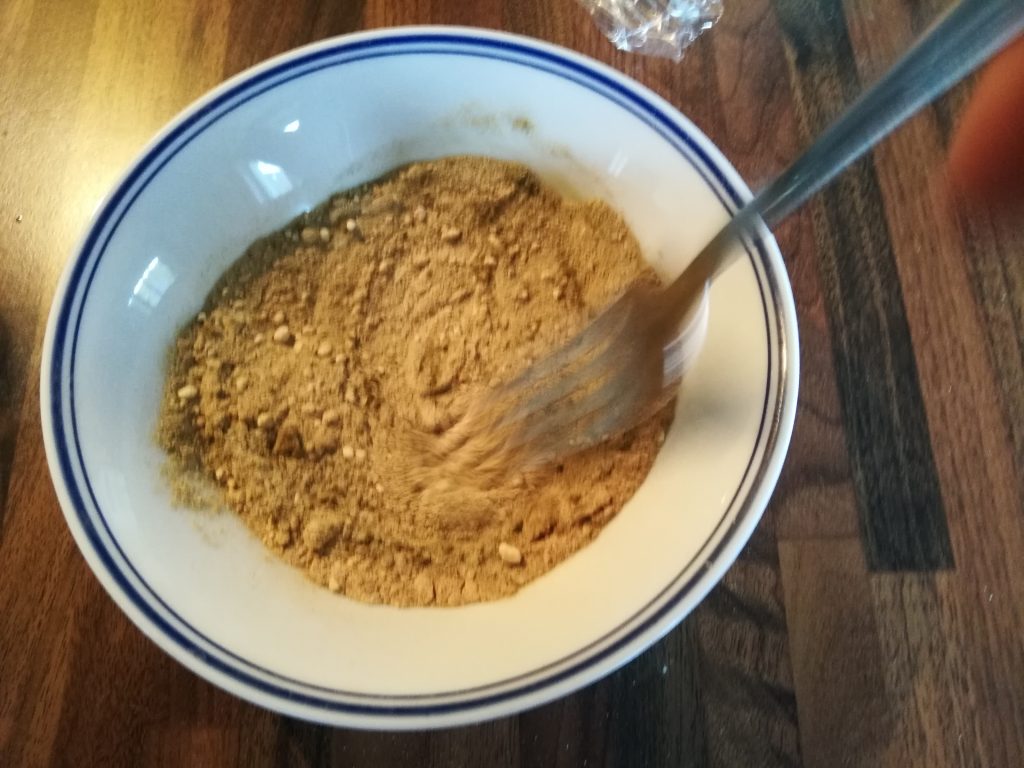
Mix the flour and the spores.The mixture is now ready for usage. You can either start a batch right away, or you can store the mixture for later use.
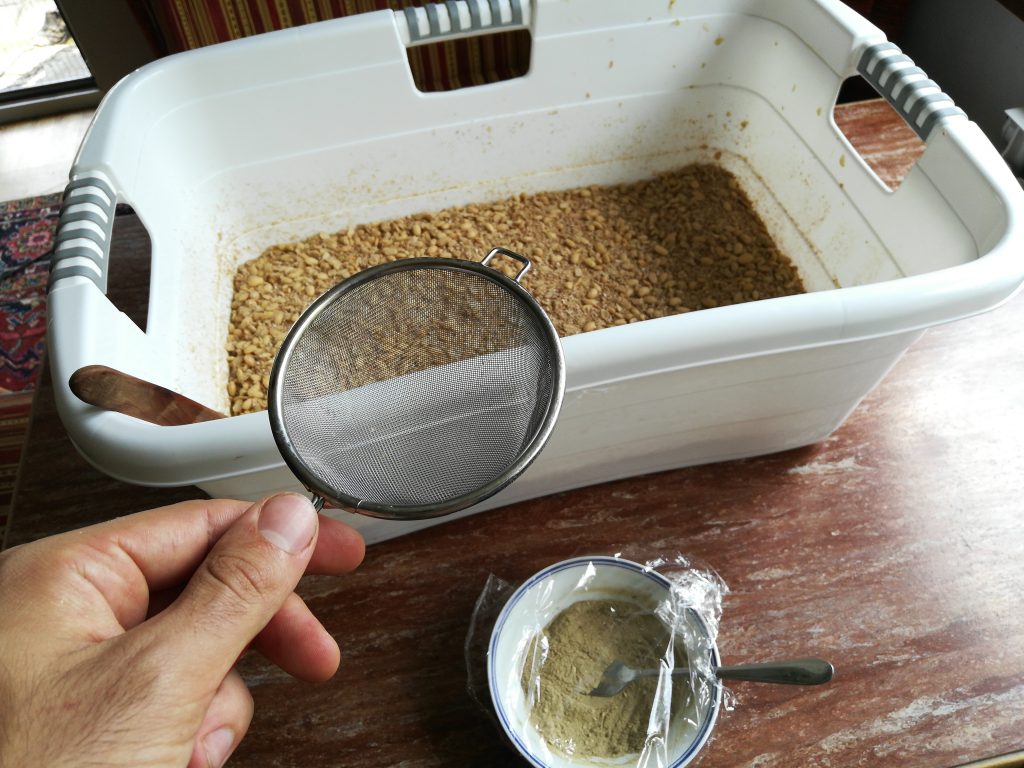
In this case, I wanted to use all of the mixture right away. If you want to start, say, 1 kg of steamed rice, simply use a fifth of your mixture. This should now amount to about 6 g.
The dilution of the spores serves two purposes: you can divide the spores more easily if you want to make less than 5 kg of Koji, and also you can spread them more easily. If I just poured the pure spores into my tea-strainer, they’d probably all end up in one spot. Now that they are diluted, I can spread them very evenly.
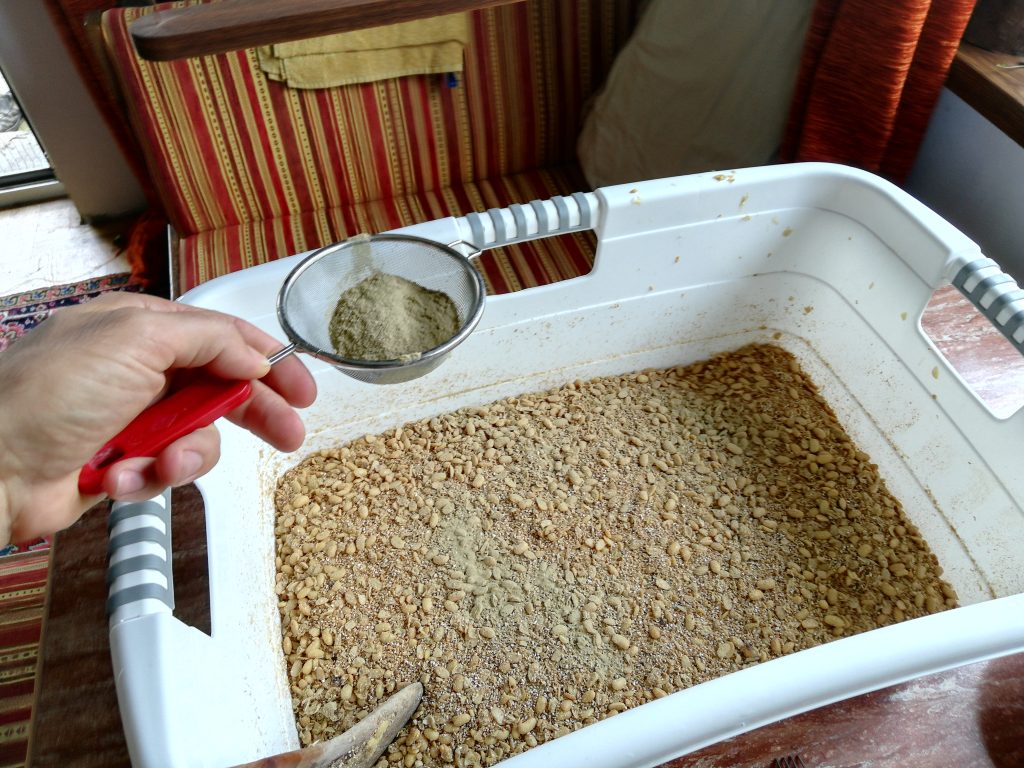
I find that a tea strainer works well for spreading the spores. In this case I was making soy sauce, if you are wondering :)
I hope this article was of help to you :) Wish you happy fermenting!
Ilona
2 Jun 2025Hallo Viktor,
du schreibst das die Sporen unverdünnt sind. Ist das nach wie vor so? Auf den Produktbilder sieht man das dort Kartoffelmehl zugesetzt ist. Stimmen denn dann noch die Mischungsverhältnisse?
Vielen Dank im Voraus für deine Antwort
Viktor
3 Jun 2025Hallo Ilona,
ja, ganz ohne Kartoffelstärke geht es nicht, anders wären die Sporen nicht hantierbar. Es ist aber sehr wenig, so dass man als Heimanwender gut beraten ist, die Sporen weiter zu verdünnen. Es liegt jeder Bestellung eine Anleitung bei, wie man die Sporen verdünnen kann.
Eve
2 Mar 2025Hi Viktor, It has been a month since I diluted the koji spores and stored in a glass jar in the fridge at 5 deg. How long can I store it this way before it loses its strength?
Viktor
1 Jun 2025Hi Eve, they will keep for 6 months easily, provided you protected the spores from moisture. Even 2-3 months after the best before date they will still work. At this point, I would just increase the dosage by 25-40% or so.
Robertas
25 Apr 2024Hello,
I want to ask about the usage rate of koji kin spores. You indicate that 0.8g spore pack is enough for 5kg of raw material. Is it 5kg of dry rice or cooked? I ask because the usage rate you provided is very different from the rates provided by the Japanese sellers themselves https://www.ebay.com.au/itm/303218039936?_trkparms=amclksrc%3DITM%26aid%3D1110025%26algo%3DHOMESPLICE.COMPOSITELISTINGS%26ao% 3D1%26asc%3D264161%26meid%3D561292c9ee6143c5a82dcf4d2bd619d1%26pid%3D101506%26rk%3D1%26rkt%3D25%26sd%3D156162715530%26itm%3D303218039 936%26pmt%3D1%26noa%3D1%26pg%3D4247815%26algv%3DAlgoIndex5SimRankerWithCassiniQueryEmbRecall&_trksid=p4247815.c101506. m1851 I don’t know, maybe they sell diluted spores. It would be better for me to buy koji kin spores from you because the shipping is cheaper and faster, because I live in Lithuania.
Viktor
25 Apr 2024Hi, the 5kg refer to cooked substrate. Compared to other vendors, our spores are undiluted to allow shipping in letters :)
Robertas Miliauskas
30 Apr 2024Hello,
It would be clearer if the spore rate was specified for the primary product, not for the already cooked one, because after cooking it is inconvenient to weigh, and besides, you need to know before cooking the product how much it will be needed for the amount of spores available.
Viktor
20 May 2024Hi Robertas,
the reason for that is because the primary product has a variable weight. While rice gains only about 40% of its weight, soybeans will gain 130% (i.e. they weigh 2.3 times as much). A reason to avoid this complication is to give the weight of the cooked product.
Lewis Pendragon
3 Apr 2023Good Afternoon Viktor, I have just purchased some Koji spores. I want to be clear with regards to the dilutant, if I use grounded rice to mix with the spores would I need to toast it to sterilise or is it classified as Starch?
Viktor
27 Apr 2023Hi Lewis,
while I think that rice is less problematic than wheatflour, I would still toast the rice to be on the safe side.
jeronimo
11 Oct 2022hi viktor my mother has frozen my spores for a few days , and then i put them back in the refrigerator. can i still prepare them? thank you!
Viktor
12 Oct 2022Hi Jeronimo,
freezing is generally not very good for the spores, but I think they will still be OK. Maybe use a bit more than normally, and it should be fine.
Iruna
19 Jul 2022Hello!
I ordered Natto and Koji spores recently and left them in a 25°C room for a few days, until I remembered to refrigerate them. I have made 3 failed attempts at making Natto with the spores. (Last setup was a dessicator set at 35°C, beans with a 3 fold dose of spores in a glass tray, covered with perforated cling film. Checked on the moisture every few hours and sprayed water on them from time to time. They only developed a foul stinky smell.)
I am wondering whether they might have lost their power in the warm period already. What do you think? Does it make sense to keep trying with these?
Best regards!
Viktor
19 Jul 2022Hello Iruna,
the 25°C should not harm the spores in any way. Especially the natto spores are very hardy, and they should not lose any power, as long as they are stored dry. I would suggest to review your natto making technique and try again :) Let me know how it works out for you in your next try!
Stephanie
28 Dec 2021Hi Viktor!
I just purchased koji spore but in excess (20g), and I want to store it in the best way possible for longevity. Does it makes a difference if I dilute the entire batch of 20g and store in the cool/dark place or is it better to keep the spores undiluted and only dilute the amount I need for each batch I make? Thank you!
Viktor
28 Dec 2021Hi Stefanie,
I think it would be slightly better to store it undiluted, but I also don’t think that it’s going to make a big difference.
Lea
2 Dec 2021Hello Viktor,
instead of toasted flour, I can also dilute the spores with starch (Speisestärke). Did I understand that correctly? Why does the starch not need to be roasted?
Viktor
22 Dec 2021Hello Lea,
you understood correctly.
It doesn’t need to be roasted, as it is very processed already. The amount of unwanted mold spores is much, much less than in normal flour.
Aya
5 Nov 2021Hello Viktor!
Do I need to dilute the Tempeh starter as well?
Viktor
5 Nov 2021Hello Aya,
not that is not necessary as they are quite diltuted already.
Konrad
6 Sep 2021Hello
we have made a number of different lot of soy-sauce; currently we are in week nr. 6 after adding the brine (Swiss Alpine salt; Sea salt; Himalayan salt). We now see on 2 of 6 fermentation pots a lot of growth of spores/mould with production of a sour smell. What has happened here? While growing the Koji we saw that some of the trays we used have developed rather strong (almost 40°C); and we have stirred frequently and used some water to spray on in order to bring the temperature down. We then realised that on the bottom of the tray, the substance was quite wet. Does anybody has an idea about the reason why the mould and the sour smell has evoked? Many thanks!
Viktor
5 Nov 2021Hello Konrad,
please excuse the late reply.
To avoid mold on your moromi, it is highly recommended to stir daily/every two days for the first 2-3 weeks. This is when the danger is highest. Later on you don’t need to stir as often.
A sour moromi is normal, it depends on what exactly you mean. You could also have a failed fermentation, in which a very chemical smell is produced, kind of like nail polish remover. If that happens, there’s unfortunately not much you can do.
To avoid overheating, I recommend to start out with thinner mats in the trays, there’s otherwise no good way to reliably avoid overheating, except for stirring, but you need to sleep at some point, you can’t be stirring all the time :)
Ezzat
1 Jun 2021Thanks for the post,Just a I noticed clerical mistake :
Put the flour into the pan and toast it until it gets light brown. The toasting is important to kill off any other mold spores that
me be (i suppose meant MAY BE)
present in the flour. Be aware that the browning can happen very quickly! I have burnt the flour more often than once. Move the flour around a lot, to avoid burning it.
Viktor
1 Jun 2021Indeed, thanks for the note!
Natalie Preston
12 Sep 2020Can I use buckwheat flour or other flours to dilute the spores?
Viktor
13 Sep 2020Hi Natalie,
of course, any flour will do.
Andrea De Santis
1 Jul 2020That’s very useful, thanks a lot, can’t wait for the spores to arrive
Chris Rankin
5 Apr 2020V,
Thanks a lot, pretty busy here at the end of the world, however I have plenty of time to experiment in solitude. I will cook the poppy seeds as you suggested, I bought already ground ones so less work. Hope you are OK over there in Austria, be safe and hope to stay in touch.
Chris Rankin
Chris Rankin
27 Mar 2020Dear Victor,
I am ordering some more spores today (I hope you are still sending stuff during the pandemic???) I have a quick question: I want to make some Miso like yours (the Poppyseed version), there are a lot of that stuff in Czech, like Austria. My question is: How do you prepare poppyseeds for Miso? Should they be whole, or ground? Cooked or raw? 100% Poppyseeds or a mix with soja? Sorry for the questions, you can keep it your “company secret” if you like, but before I waste a lot of material experimenting I though I would ask the professionals. Thanks in advance, Chris
Viktor
29 Mar 2020Hi Chris,
we still send despite the pandemic.
The poppyseeds should be ground. I then mix them with 110% water (i.e. for 1 kg of dry seeds I add 1.1 kg of water). The mix should then be steamed for half an hour or so. You could also just put it in the oven, but cover it, so that it doesn’t dry out.
The result will be a bit like a cake. Let it cool out and then mince it together with fresh rice koji (1:1). I use 7% salt. I wouldn’t use any less, because otherwise your miso is going to taste too yeasty (at least in my opinion)
Hope that helps!
chris
9 Mar 2020V,
Thanks for the info, so far so good…miso growing like wild already.
Chris
Christopher Rankin
5 Mar 2020Hello Victor,
I am starting my Koji work today, I will produce 5 Kilograms of the koji rice at first. I have the perfect incubator (from my cheese production work). I have a question; how should I store the infected rice (Koji Rice)? I will use SOME to make Miso, however I plan to test making other things as well before ordering more spores. I understand the infected rice should be refrigerated, But also shrinkwrapped? or Frozen? Also there are dried koji-rice products available here (new stuff) however they are DRY…is that suggested as well (if so; how to accomplish that…veg drier, freeze drier, sun???)? Sorry to be a bother, but just trying to do things correctly.
Thanks,
Chris from Czech Republic
Viktor
6 Mar 2020Hi Christopher,
you can store the koji in your fridge for a week. Vacuum is not necessary.
If you want to store it for a longer time, you can just freeze it, no problem.
We dry our koji for postage, it’s the best way to ensure the highest quality for anybody who orders from us. But if you can just keep up a cooling chain (easy at home ;) ), there’s no need to dry it.
Greetings,
Viktor
Casper
22 Aug 2018Hello Viktor,
How do you best keep the spores for later use, can they be frozen or example?
Viktor Gruber
22 Aug 2018Freezing is not good for the spores. They are best stored in a cool, dark and dry place. Slightly below room-temperature is good. They will stay viable for at least a year. After that, you can just use a bit more spores to make up for any lost vitality.